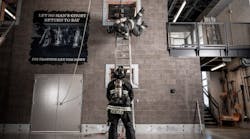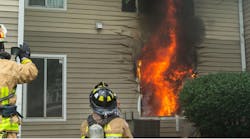Session Reference: 1-1
Topic: Salvage
Time Required: 2 Hours
Materials:
• Various Items of Salvage Equipment
• Salvage Covers
References:
• Truck Company Fireground Operations, Second Edition, Chapter 10
• Essentials of Fire Fighting, Third Edition, Chapter 14
PREPARATION:
Motivation:
Objective (SPO): 1-1
The student will demonstrate a basic understanding of protecting building contents, removing water from buildings, pre-inspection, and performing salvage operations.
Overview:
Salvage
• Introduction to salvage
• Protecting building contents
• Removing water from buildings
Session 1-1 Salvage and Overhaul
SPO 1-1 The student will demonstrate a basic understanding of protecting building contents, removing water from buildings, pre-inspection, and performing salvage operations.
1-1-1 Describe the concept of salvage and how it contributes to conserving property.
1-1-2 Describe methods used to protect building contents from water.
1-1-3 Describe methods of water removing water from buildings.
I. Introduction to Salvage (1-1-1)
A. Water used to limit fire damage can damage building and ruin contents
B. Salvage operations can reduce water damage
C. Two types of salvage operations
1. Those that protect contents of building
2. Those that protect building itself from structural damage
3. First entails proper placement of salvage covers and second requires water removal
D. Salvage operations often neglected because of supposed lack of personnel
E. Makes little sense to put effort into controlling fire while allowing water to ruin office equipment or domestic furnishings
F. Misconception that salvage is related to overhaul
1. Main objective of salvage is to protect building and contents from water damage; main objective of
overhaul is to make sure fire is completely out
2. Salvage operations should start as soon as attack begins; overhaul operations not started until fire
extinguished
3. Salvage operations performed with salvage tools; overhaul requires truck tools and hoselines
G. Type of salvage operations required in particular building depends to some extent on construction
1. Floors made of concrete usually will hold water
2. Water will seep quickly through wooden floors
H. Size up of situation will indicate which salvage operations should be initiated first and where
I. Should be no hesitation in calling for extra companies to perform salvage operations
II. Protecting Building Contents (1-1-2)
A. Salvage covers
1. Usually large sheets of waterproof material
a. Available in several sizes, materials, and shapes
b. Some fire resistant
c. Some must be placed with particular side open
2. Fire fighters should be familiar with type of covers carried
3. Various ways of folding covers for transporting
a. Appearance of folded covers should indicate whether it can be spread by one person or more
required
b. Cover should be tagged to indicate number of personnel required for use
4. Types of covers used, folding methods, and carrying and spreading techniques should be
standardized
B. Covering building contents
1. Covers should first be spread over contents in most danger of water damage
a. In most cases, those on floor below fire floor, directly under fire
b. In rare instances, area under fire contains few items that would be damaged by water
c. Important point is to first cover items that could suffer most water damage because of either
position or value
2. Covers can be rigged over shelves mounted on walls
3. Covers should also be spread over contents on fire floor and floor above fire when operations
necessitate
4. When number of covers limited, available covers should protect most valuable contents
C. Controlling water flow
1. Covers can be used to control flow of water
a. Placed in doorway to block movement of water
b. Used as conduits to direct accumulated water to stairways and then down stairways and out
through exterior doorways
c. Can be used on floor to guide water
2. Sawdust, can be spread to absorb water and control flow of water
D. Catchalls
1. Covers can be rigged as basins to catch and hold water
a. Cover can be rolled from all edges to form flat, shallow catchall
b. Draped over four ladders or other suitable material to form deep catchall
2. Catchalls effective in keeping moderate amounts of water off contents and preventing water from
moving around floor or seeping
3. Once catchall filled, must be dumped carefully
4. If catchall too heavy to move, portable pumps can be used
III. Removing Water from Buildings (1-1-3)
Sooner water is removed, less damage it will do to floors and carpets and less chance of leakage to lower floors
A. Chutes
1. In addition to rolled cover conduits, more permanent chutes can be made from cover material
a. Strip of cover material about 10 to 12 feet long
b. Pair of wood poles or aluminum pipes of same length
c. Long edge of strip rolled and fastened to poles
2. Can be rigged below hole on short straight ladder or A-frame type ladder
a. Ladder should be tall enough to hold upper end of chute close to hole
b. Poles can be tied to ladder
c. Covers can be spread over items close to chute
d. Lower end of chute should extend far enough out window so water will not fall back into
building
3. Chute can be fabricated from funnel-type device and old hose
a. Bar across salvage hole to support chute
b. Hose run out window or into drainage system
c. Drain screen can be constructed as part of top of chute
B. Drains
1. Floor and wall drains can be used if located fairly close to accumulation of water
2. Large quantities of water should not be moved to small drains
3. Drains must be kept free of debris
4. Built-in drains must be used in combination with other water removal methods
5. Locations of adequate drains should be determined during pre-fire planning surveys
6. Floor drains ideal outlets for water
7. Wall drains (scuppers) ideal for removing water
C. Toilets
1. When toilet unbolted from floor and lifted out of place, sewer pipe opening exposed
2. Flooring in bathroom usually most water resistant in building
3. Sewer pipe not usually sealed to floor around it, water can drop down to lower stores through
space between pipe and floor
4. Salvage cover can be placed on far side of pipe to keep water from flowing past it
5. Ceiling below toilet should be checked for leakage
6. Drain screen should be placed over opening
D. Sewer pipes
1. In some structures, sewer pipes exposed
a. Usually run along one wall of building
b. In stores, most often located in rear work areas
2. Because sewer pipes must be broken to be used, small amounts of water should be removed by
other means
a. Sewer pipe is knocked open at floor level
b. Drain screen should be placed over opening
3. Operation can be repeated on several floors with pipe on uppermost floor opened first
E. Openings in walls
1. Large openings may be required to get water out
2. Such opening can be made by removing wall immediately below window, from sill to floor
a. Be careful not to cut or damage structural members
b. Close or cover windows below opening
c. Wall cut will first be used on floor below fire
3. Crews must be kept informed of fire situation above them and amount of water on fire floor
4. Must also be on lookout for signs of building collapse
5. Once fire extinguished, wall opening can be made on fire floor
F. Pumps
1. Various types and sizes of portable pumps available
2. Can be used alone or in combination with other water removal methods
3. Most pumps have small capacities so cannot be used for quick removal of appreciable amount of
water
4. Pumps effective in areas of building where other means not feasible
5. Elevator and large utility shaft pits can be used to quickly remove water from upper floors
a. Effective only when bottom of bit is below basement floor
b. Pump used to remove water from pit
6. Front line pumpers should not be used to remove water from basements or pits because of debris
7. Be very careful when entering flooded area to determine location of floor, stairs, and other
obstacles
8. Fire fighters should not put faces under water or close to water surface to open clogged drain
SUMMARY:
Review:
Salvage
• Introduction to salvage
• Protecting building contents
• Removing water from buildings






